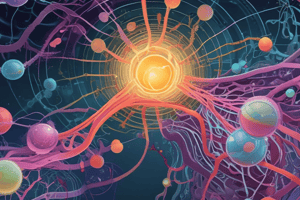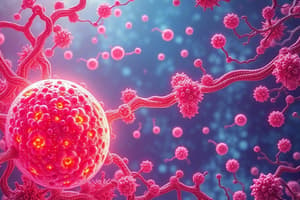Podcast
Questions and Answers
What is the process that can happen on its own, without input of external energy?
What is the process that can happen on its own, without input of external energy?
- Catabolism
- Anabolism
- Bioenergetics
- Spontaneous work (correct)
Which process literally means 'building up', producing more complex molecules from simpler molecules?
Which process literally means 'building up', producing more complex molecules from simpler molecules?
- Catabolism
- Spontaneous work
- Anabolism (correct)
- Metabolism
What does catabolism literally mean and involve?
What does catabolism literally mean and involve?
- Breaking down complex molecules into simpler molecules (correct)
- Building up complex molecules from simpler molecules
- Producing energy for cellular work
- Releasing potential energy
What is the sum of the biochemical/metabolic/cellular reactions of an organism or cell?
What is the sum of the biochemical/metabolic/cellular reactions of an organism or cell?
What is the main function of high energy electrons (HEEs) in the context of cellular respiration?
What is the main function of high energy electrons (HEEs) in the context of cellular respiration?
What represents the loss of electrons in the context of cellular respiration?
What represents the loss of electrons in the context of cellular respiration?
Which enzyme is involved in the reduction of NAD+ during the citric acid cycle?
Which enzyme is involved in the reduction of NAD+ during the citric acid cycle?
What is the main function of FADH2 in cellular respiration?
What is the main function of FADH2 in cellular respiration?
What is the overall function of the respiratory electron transport chain?
What is the overall function of the respiratory electron transport chain?
What is the product of the linker reaction that links glycolysis to the citric acid cycle?
What is the product of the linker reaction that links glycolysis to the citric acid cycle?
What represents the majority of the chemical potential energy (CPE) of glucose in cellular respiration?
What represents the majority of the chemical potential energy (CPE) of glucose in cellular respiration?
What is the main function of ATP synthase in cellular respiration?
What is the main function of ATP synthase in cellular respiration?
What is the role of H+s in the context of oxidative phosphorylation?
What is the role of H+s in the context of oxidative phosphorylation?
What is the product of the reduction of NAD+?
What is the product of the reduction of NAD+?
What is the main function of high energy electrons in compounds that can be combusted in the presence of O2?
What is the main function of high energy electrons in compounds that can be combusted in the presence of O2?
What is the site of the citric acid cycle in the cell?
What is the site of the citric acid cycle in the cell?
What is the portion of a system's energy that can be used to perform work?
What is the portion of a system's energy that can be used to perform work?
Which measure indicates disorder and randomness in a system?
Which measure indicates disorder and randomness in a system?
What determines if a reaction is spontaneous or non-spontaneous?
What determines if a reaction is spontaneous or non-spontaneous?
Which molecule is considered the energy currency of a cell?
Which molecule is considered the energy currency of a cell?
Which reaction is commonly used to drive forward nonspontaneous reactions in cells?
Which reaction is commonly used to drive forward nonspontaneous reactions in cells?
Which law of thermodynamics states that energy is conserved?
Which law of thermodynamics states that energy is conserved?
Which law of thermodynamics states that entropy increases in energy transformations?
Which law of thermodynamics states that entropy increases in energy transformations?
What are proteins that catalyze reactions known as?
What are proteins that catalyze reactions known as?
Which biochemical pathway involves sequential reactions catalyzed by unique enzymes?
Which biochemical pathway involves sequential reactions catalyzed by unique enzymes?
What is the cellular analogy for ATP in the context of energy?
What is the cellular analogy for ATP in the context of energy?
What is the eventual fate of all energy in a system?
What is the eventual fate of all energy in a system?
What is the common cellular work analogized to in the context of cellular energy?
What is the common cellular work analogized to in the context of cellular energy?
What is the role of ATP hydrolysis in cellular metabolism?
What is the role of ATP hydrolysis in cellular metabolism?
What is the function of enzymes in biochemical reactions?
What is the function of enzymes in biochemical reactions?
What is a common regulatory mode for enzymes in metabolism?
What is a common regulatory mode for enzymes in metabolism?
Which process is fundamental for ATP regeneration in cellular metabolism?
Which process is fundamental for ATP regeneration in cellular metabolism?
What represents chemical potential energy and is catabolized in ACR to regenerate ATP?
What represents chemical potential energy and is catabolized in ACR to regenerate ATP?
What is a waste product of Aerobic Cellular Respiration (ACR)?
What is a waste product of Aerobic Cellular Respiration (ACR)?
Which mechanism is the major ATP regeneration process in the presence of O2?
Which mechanism is the major ATP regeneration process in the presence of O2?
What is the role of activation energy (EA) in biochemical reactions?
What is the role of activation energy (EA) in biochemical reactions?
What happens to the transition state of spontaneous reactions?
What happens to the transition state of spontaneous reactions?
What effect do catalysts like enzymes have on activation energy (EA)?
What effect do catalysts like enzymes have on activation energy (EA)?
What is the function of ATP in cellular metabolism?
What is the function of ATP in cellular metabolism?
What is the primary function of the respiratory electron transport chain in ATP regeneration?
What is the primary function of the respiratory electron transport chain in ATP regeneration?
Flashcards are hidden until you start studying
Study Notes
Cellular Metabolism and ATP Regeneration
- ATP hydrolysis is a coupling reaction to minimize energy wastage
- Spontaneous reactions have an unstable transition state with high Gibbs energy
- Activation energy (EA) is a barrier to reactions and can be overcome by adding heat or using enzymes
- Enzymes are proteins that catalyze biochemical reactions and show specificity
- Catalysts such as enzymes lower the EA, enabling spontaneous reactions to occur
- Enzymes control metabolism and can be up-regulated or down-regulated
- Feedback inhibition by the end-product is a common regulatory mode for enzymes
- Aerobic Cellular Respiration (ACR) is a fundamental process for ATP regeneration
- ACR involves glycolysis, citric acid cycle, respiratory electron transport chain, and ATP synthase
- Glucose represents chemical potential energy and is catabolized in ACR to regenerate ATP
- CO2 is a waste product of ACR and is formed from the catabolism of glucose
- ATP regeneration in ACR occurs through substrate-level phosphorylation and oxidative phosphorylation, with the latter being the major mechanism in the presence of O2
Studying That Suits You
Use AI to generate personalized quizzes and flashcards to suit your learning preferences.




